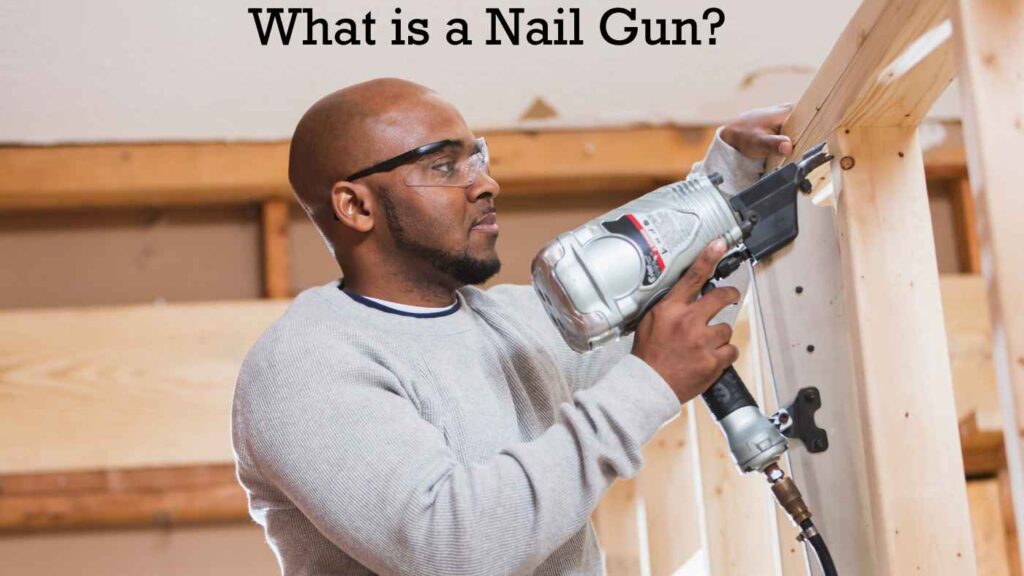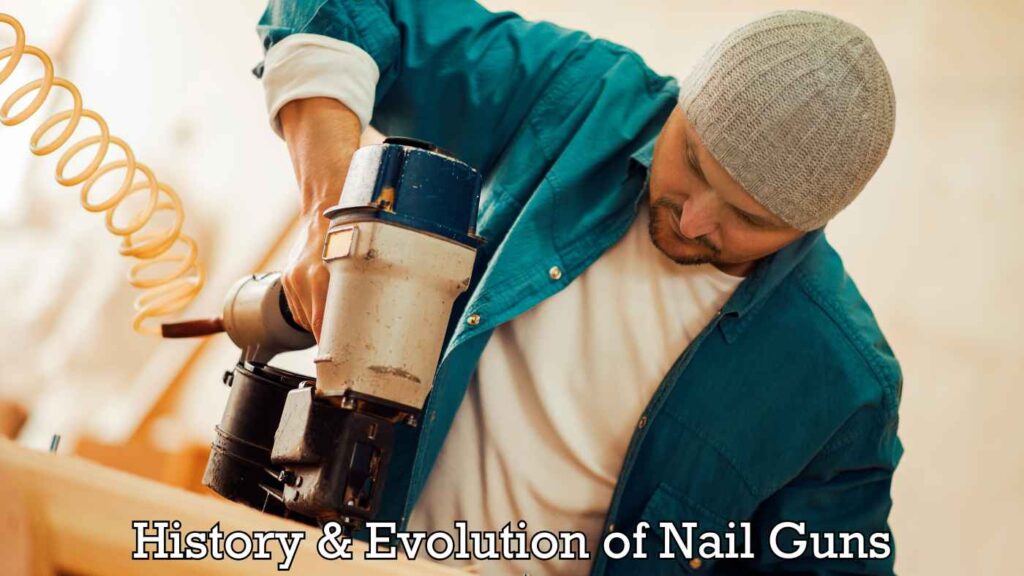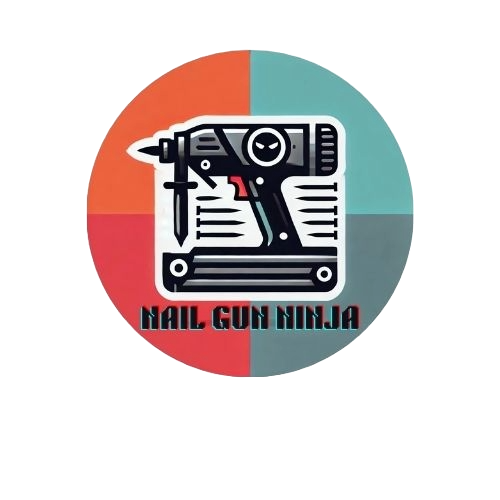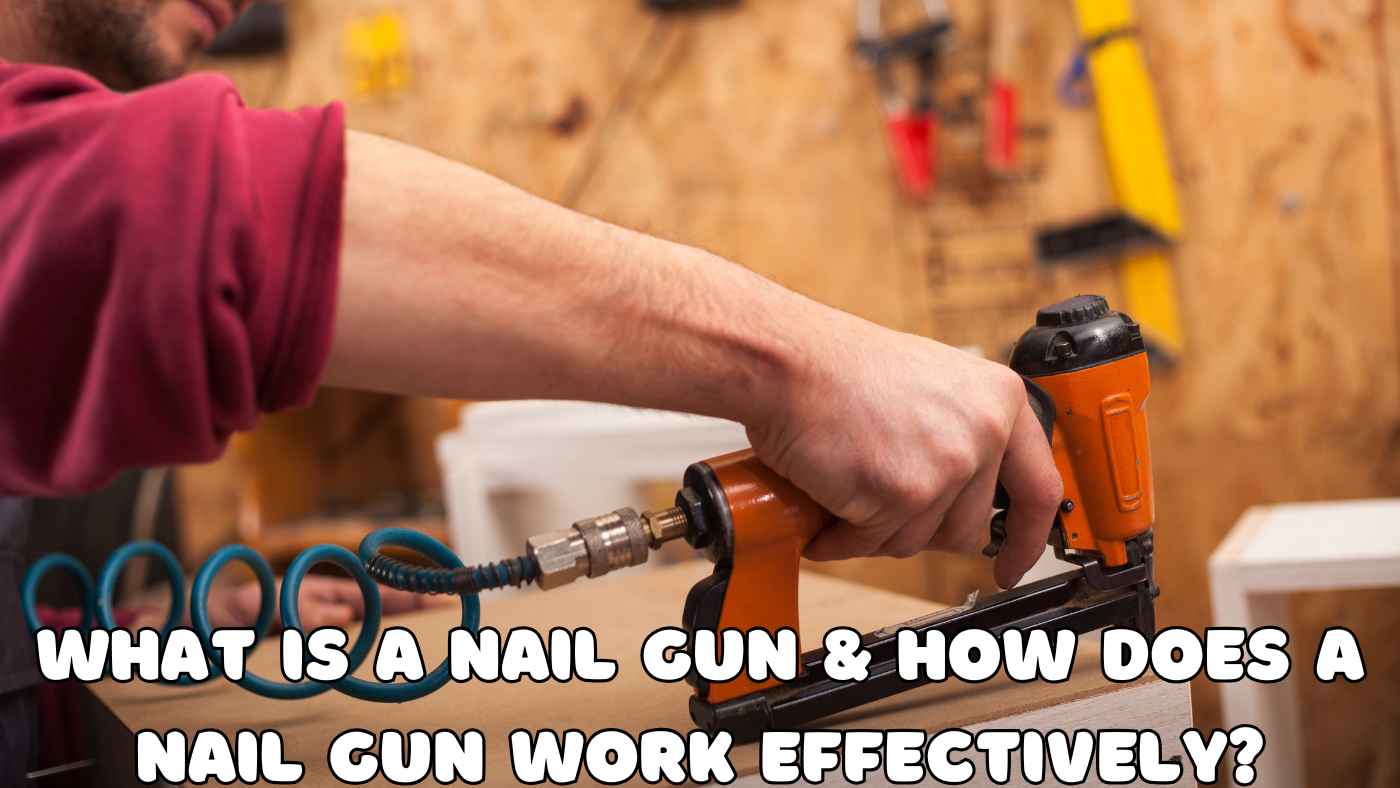If you ever work on a DIY or construction project, you might ask yourself how can you make your project faster and more efficient. The answer is a tool called a nail gun.
A nail gun is an effective fastening tool that is also called a “Nailer”. Moreover, it is also known by different names such as nailer gun, nailing gun, and gun nailer. People from different regions call it by different names.
Whatever, what is a nail gun and how does it work? If you are building a deck, framing a house, or working on a small craft project, a nail gun can make the job easier.
What is a Nail Gun?

A nail gun is a powerful tool that helps drive nails into materials like wood or concrete quickly and efficiently.
It is operated by using compressed air, electricity, or gas combustion to provide strong, consistent force. Their operation depends on their power sources and models.
Because of its speed and precision, it’s a must have tool for construction, carpentry, and DIY projects.
Brief History & Evolution of Nail Guns
The nail gun was first invented in 1950 by Morris Pynoos. He was a civil engineer. He designed it to speed up the construction of Howard Hughes’ famous “Spruce Goose” airplane.
The earliest versions of the nailer were pneumatic. It means they used compressed air to drive nails effectively. By the 1960s, nail guns had become essential in construction tasks like framing and roofing.

In the 1970s and 1980s, electric nail guns were introduced with more portability and accessibility for DIYers.
Around the same time, gas powered models were developed for heavy duty jobs that required more mobility.
Over the years, nail guns have evolved to include features like adjustable depth settings, sequential and bump firing modes, and safety mechanisms to reduce the risk of accidents.
Today, there are many types of nail guns such as brad nailers, finish nailers, framing nailers, and staplers. Each type is designed for specific tasks and makes them versatile for both professionals and hobbyists.
From large construction sites to small craft projects, nailer guns are known for their speed, precision, and adaptability.
Types of Nailer Guns & Their Uses: A Short Overview
Choosing the right nail gun depends on the type of project and material you are working on. Nail guns come in different styles, each designed for specific tasks.
Knowing the differences can help you work more efficiently.
Here is a list of nail guns with their specific uses:
Framing Nail Gun
A framing nail gun is built for heavy duty jobs that require strong and secure fastening.
Common Uses
- Framing houses: Essential for building the wooden framework of a house.
- Decking: Ensures deck boards are fastened securely to the frame.
- Fencing: Great for assembling and reinforcing fences.
- Sheathing: Helps attach plywood or OSB to exterior walls.
Framing gun nailers use nails ranging from 15 degree to 34 degree angles. Depending on building codes, they may use either clipped head or full round head nails.
Brad Nailer
Brad nailers are made for detail work and precision. They use 18 gauge nails, which are thin and short.
Common Uses
- Delicate trim work: Perfect for attaching thin trim pieces without splitting the wood.
- Baseboards: Provides a secure hold while keeping nail holes small.
- Molding: Great for crown molding and other decorative elements.
- Craft projects: Works well for small woodworking tasks.
Brad nail guns hold materials firmly to reduce the risk of damage to delicate surfaces.
Finish Nailer
A finish nailer is stronger than a brad nailer that uses 15 gauge or 16 gauge nails.
Common Uses
- Cabinetry: Securely fastens cabinets.
- Furniture making: Provides strong holding power without excessive damage.
- Door and window trims: Ensures a firm hold without large nail holes.
- Wainscoting and paneling: Ideal for securing decorative wood panels.
Finish nailer guns offer a balance between strength with a polished and professional look.
Roofing Nailer
Roofing nailers are designed for fast and repetitive nailing. They mainly use coil nails
Common Uses
- Installing asphalt shingles: Ensures the roof shingles will stay in place against wind and weather.
- Attaching waterproof tar paper: Helps in layering roofing materials properly.
- Installing insulation boards: Used in roofing projects that need extra insulation.
Roofing nail guns are built for speed and high volume nailing to make them essential for roofing professionals.
Siding Nailer
A siding nailer is used to install siding materials quickly and efficiently without causing damage.
Common Uses
- Siding installation: Works well for fiber cement siding and wood siding.
- Exterior wall sheathing: Provides strong holding power without splitting siding panels.
- Lap siding projects: Allows for quick and secure fastening.
These nailers typically use coil nails with rust resistant coatings to be protected from outdoor conditions.
Pin Nailer
Pin nailers are the most delicate type and use 23 gauge headless nails.
Common Uses
- Fine woodworking: Great for detailed joinery and small wooden projects.
- Attaching small trims: Offers almost invisible fastening.
- Furniture detailing: Used for intricate furniture accents.
- Temporary holding before gluing: Keep small pieces in place before the glue dries.
Pin nails don’t provide strong holding power but are perfect for finishing work. They offer a professional and aesthetic output.
Staple Gun
A staple gun is not a traditional nail gun. But it works quite similarly.
Common Uses
- Sheathing: Securing plywood to walls or roofs.
- Upholstery: Attaching fabric to furniture frames.
- Insulation: Holding insulation sheets in place.
- Carpet installation: Securing carpets and rugs effectively.
Staple guns use wide and flat staples instead of nails. These nails are perfect for soft and thin materials.
Top 3 Branded Nail Guns Preferred by the Nailing Experts for Precision and Durability.
| Image | Product | Feature | Price |
|---|---|---|---|
Trending  | DEWALT 18GA Brad Nailer (DWFP12231) | Pneumatic with 5/8″ to 2″ nails, tool-free adjustments, rear exhaust, and ergonomic grip. | Check on Amazon |
Trending  | BOSTITCH 16GA Finish Nailer (BTFP71917) | Pneumatic with smart point technology, 1-1/4″ to 2-1/2″ nails, and tool-free jam release. | Check on Amazon |
Trending  | Metabo HPT Framing Nailer (NR90AES1) | Pro Preferred Brand of Pneumatic Nailers, 21 Degree Magazine, 2″ to 3-1/2″ Plastic Collated Nails. | Check on Amazon |
Nailer Gun Power Sources
The power source of a nail gun plays a crucial role in its performance, mobility, and ease of use.
Here is the list of four main nail gun power sources:
Pneumatic Nail Guns
Air compressors come as the main power source of pneumatic nail guns. They are operated by compressed air.
Pros
- Delivers a strong driving force to make it perfect for heavy duty work.
- Ensures consistent performance and fast firing speeds.
- Generally more durable and cost effective over time.
Cons
- Requires an air hose and compressor which limits the portability.
- The setup can be bulky and less convenient for quick tasks.
Cordless (Battery Powered) Nail Guns
Battery powered or cordless nail guns are operated by rechargeable Lithium-Ion batteries. They don’t require any cords. Just insert the battery and start nailing.
Pros
- They are completely portable with no need for air hoses or compressors.
- Quick and faster setup. You can apply them for on-the-go projects.
- Produce less noise compared to pneumatic nailer models.
Cons
- Batteries require regular charging which can slow down workflow.
- Less powerful than pneumatic models.
- Not suitable for heavy jobs.
- Higher cost due to battery and charger expenses.
Gas Powered Nail Guns
Gas powered nailers are operated by fuel cells combined with a battery for ignition. These nailers come with various gas cartridges.
Pros
- Provides power similar to pneumatic models without the need for an air compressor.
- High movability makes them ideal for outdoor work and large job sites.
- Strong enough to drive nails into dense materials like hardwood.
Cons
- Requires frequent fuel cell replacements. It causes adding to long term costs.
- Produces a gas odor and needs good ventilation.
- Cold temperatures can affect the ignition and performance of this type of power source.
Electric Nail Guns
Electric nail guns are simply powered by electricity. They come in 2 variations. One is corded and the other one is cordless.
The corded ones are directly connected by a standard electrical outlet.
Pros
- Provides steady power without any requirement for fuel or battery charging.
- Lightweight and simple to operate.
- Needs less maintenance compared to pneumatic and gas powered power sources.
Cons
- Limited by the need for a power outlet.
- No power outlet in the work area reduces mobility and portability.
- Weaker than pneumatic and gas powered models.
- Not suitable for heavy-duty structural projects.
- The cord can get in the way, especially in large workspaces.
Common Uses of Nailer Guns
Nail guns are incredibly useful in construction, woodworking, and DIY projects. They save time, increase efficiency, and provide precision.
Here is a list of common uses of nail guns:
Framing
Framing nail guns are key for large construction jobs like building houses and other heavy structures.
These guns use large and strong nails (usually 16d or 20d). These nails drive into thick lumber and plywood. They are perfect for framing walls, floors, and roofs.
Trim & Molding Installation
When it comes to trim and molding, precision is essential. A finish or brad nail gun is ideal for this job. These guns use smaller gauge nails like 16 gauge for finish nails and 18 gauge for brad nails.
These small nails leave tiny holes that can be easily filled and painted over. This makes them great for trim work. They are perfect for fine woodworking where the final look is important.
Decking
Building a deck can be a time consuming process. A decking nail gun helps speed things up. These nail guns are designed to drive nails into the decking boards and the joists.
Decking nailers typically use longer nails like 8d or 10d. They are better for holding power. With a nail gun, you can secure hundreds of boards quickly.
Fencing
When building wooden fences, nail guns make the job much easier. A framing nail gun or coil nail gun is often used to attach the pickets to the rails.
These tools let workers quickly drive nails into the boards. They eliminate the use of hammers. Coil nail guns are especially useful for fencing because they hold a lot of nails.
Cabinet Making & Furniture
In fine woodworking, like cabinet making or furniture assembly, precision is key. Nail guns are commonly used to put together parts of cabinets, chairs, tables, and other furniture.
A brad nailer or finish nailer is often used to attach smaller pieces of wood, such as trim and moldings.
Roofing
Roofing projects require a specialized tool, that is called the roofing nailer. They are designed to handle large and flat nails for installing roof shingles and underlayment.
Roofing nailers are equipped with a coil magazine to hold many nails to install shingles quickly.
They are efficient at securing shingles while making sure they are driven into the roof deck, even in harsh weather conditions.
Pallets & Crates
In the manufacturing of pallets, crates, and other shipping structures, industrial nail guns, such as coil nailers and framing nailers, are essential.
These heavy duty tools can easily drive nails through thick lumber to ensure fast and secure assembly of pallets and crates.
Nail guns are needed to keep the production process fast and efficient, as hundreds or even thousands of structures might need to be built daily.
Upholstery
In the upholstery industry, brad or pin nailers are used to attach fabric or leather to wooden frames.
These small and thin nails are perfect for delicate tasks that require a clean finish. They won’t cause the fabric to tear and ensure a smooth and professional look.
Brad and pin nail guns are used for tasks like attaching upholstered panels, cushions, and decorative trim to furniture frames.
Siding
Nail guns are a must have tool when installing siding with materials like vinyl, wood, and fiber cement.
A siding nailer, which is usually a coil nailer, is perfect for quickly securing large sheets of siding to a building’s frame.
Flooring
When installing hardwood or engineered wood flooring, a flooring nailer is the best tool. These nail guns are designed to drive nails into the tongue of each floorboard at an angle, ensuring a tight fit.
Flooring nailers use cleat nails or staples which provide a strong bond to hold the boards securely over time. This tool is especially helpful for large flooring projects.
Masonry & Concrete
When working with tough materials like concrete and masonry, you need specialized nail guns, such as powder actuated nail guns.
These tools use a cartridge to shoot nails into hard surfaces like concrete, brick, or steel. They are essential for tasks such as attaching framing studs, brackets, and anchor bolts.
These tools provide the high force necessary to penetrate hard materials quickly and securely. These tools eliminate the need for drilling or other complex methods.
What is Inside a Nail Gun?
A nail gun may seem like a basic tool, but it consists of several parts that work together to drive nails quickly and effectively.
Here is a simple explanation of its key components:
Trigger
The trigger is what you press to fire a nail. Different nail guns may have various triggering modes:
Sequential Trigger
Fires one nail at a time when you press both the trigger and safety tip.
Contact Trigger
Fires nails continuously as long as you hold the trigger and press the safety tip.
Nail Magazine
The nail magazine is where the nails are stored inside the nail gun. It works like the clip in a stapler but larger. Nails are placed in a strip or coil and fed into the firing mechanism one by one.
Firing Mechanism
This is the main part of the nail gun. This part is responsible for driving the nail into the material.
The firing mechanism can be powered by different sources such as pneumatic, batter power, gas powered, and electric.
Piston
The piston is a small but powerful part that moves quickly to push the nail from the magazine into the nailing place.
Safety Tip
The safety tip is a vital safety feature that prevents accidental firing. It must be pressed against a surface before the trigger can fire a nail.
Exhaust Port of Pneumatic Nail Guns
If you are using a pneumatic nail gun, you will definitely find an exhaust port. This is where air escapes after firing a nail.
Some models let you adjust the exhaust direction to keep air away from your face.
Depth Adjustment
The depth adjustment setting allows you to control how deep the nails are driven into the material.
It is especially useful when working with different wood or material types.
Driver Blade
The driver blade is the part that strikes the nail. Attached to the piston, it moves at high speed to drive the nail into your material.
Nail Chamber
The nail chamber holds the nail just before it is fired. It aligns the nail with the driver blade to ensure accuracy. It helps the nail guns to be accurate.
Handle and Grip
The handle is designed to give you comfort and control handling. Many models include rubberized grips to reduce fatigue during long projects.
Air Inlet
For pneumatic nail guns, the air inlet is where the air hose from the compressor connects. It is located near the handle.
Battery Compartment
For cordless models, the battery compartment stores the rechargeable battery that powers the tool.
How Does a Nail Gun Work? Step by Step
There are some processes of operating a nail gun. You have to follow the process step by step from starting to ending.
Step 1: Pull the Trigger
When you pull the trigger the nail gun will be activated and start the firing process. Depending on the trigger type, the gun will fire differently.
You can use the contact firing method or bump firing method depending on the project.
Step 2: Power Source Activation
Pulling the trigger activates the power source. Connect your nail gun based on the power source it uses.
Step 3: Driver Blade or Piston Movement
The power source pushes the driver blade or piston forward to move the nail from the magazine into the firing chamber.
Step 4: Nail Loading
The magazine of the nail gun holds nails in either strips or coils. When the trigger is pulled a nail is fed into the firing chamber. Then it will be ready to drive into the material.
Step 5: Firing the Nail
The driver blade or piston pushes the nail at high speed into the material.
Step 6: Return Stroke
After firing, the piston or driver blade moves back to its starting position. Then the next nail will load into the chamber.
Step 7: Safety Features
To prevent accidental firing, nail guns include safety features such as:
- Contact Safety: The gun only fires when the nose is pressed against the surface.
- Trigger Safety: Requires pressure on the firing trigger.
Step 8: Ejecting the Spent Nails
After a nail is driven, the spent nail or strip remnants are ejected. It will make space for the next nail to be fired.
Benefits of Using a Nailer
Using a nail gun instead of a hammer offers many benefits like:
Faster & More Efficient
A nail gun can shoot several nails in just a few seconds, which speeds up the job and saves time.
Greater Accuracy
The nails are driven straight and securely, which helps reduce errors.
Less Hand Strain
No more repetitive hammering that can tire out your wrist and arm.
Versatility
Nail guns come in different types, making them suitable for everything from large construction projects to detailed woodworking tasks.
Nail Gun Maintenance & Care
Proper maintenance ensures longevity, safety, and optimal performance.
Follow these steps:
- Cleaning: Wipe the exterior of the tool body after each use. Clean the magazine and firing mechanism.
- Lubrication: Add 2–3 drops of oil to pneumatic nailers before use.
- Fasteners: Check and tighten screws, bolts, and fittings to prevent air leaks and misfiring.
- Air Compressor: Set the correct PSI, drain moisture daily, and inspect hoses carefully.
- Replace Worn Parts: Inspect O-rings, gaskets, and driver blades. If worn or damaged then replace.
- Magazine Care: Keep clean, avoid overloading, and clear jams immediately.
- Storage: Disconnect the power sources while storing. Store in a dry place with a protective case.
- Follow the Manufacturer’s Guide: Use only approved nail gun kits and follow manual instructions.
Safety Tips for Using a Nail Gun
Follow these essential safety tips when using a nail gun:
- Read the Manual: Be familiar with your specific nail gun model and safety instructions.
- Use Correct Nails: Ensure the right size and type of nails for your nailer and project.
- Wear Protective Gear: Always wear safety glasses, hearing protection, and gloves.
- Safety Mechanism: Keep the safety features engaged when not in use.
- Keep Hands Clear: Never place your hands in front of the firing area.
- Disconnect Power: Disconnect air, battery, or gas when not in use or during maintenance.
FAQs
1. Are nail guns safe?
Ans: Nail guns are safe when used correctly but can be hazardous if mishandled. Particularly, pneumatic nail guns could be hazardous if not controlled properly.
2. Is a nail gun better than a hammer?
Ans: A nail gun is generally better than a hammer for speed, efficiency, and consistency.
3. How powerful is a nail gun?
Ans: Nail gun power varies based on the type and model you are using. Pneumatic nail guns produce much more power than other cordless or electric nailers. Gas powered nail guns also produce better power.
4. How fast does a nail gun shoot in mph?
Ans: A nail gun shoots nails at 955 to 2045 mph, much faster than the speed of sound. But your project and materials will justify how fast does a nail gun shoot.
5. Are nail guns loud?
Ans: Yes, nail guns are loud. They can create noise levels ranging from 85 to 120 dB. But it mainly depends on the type. Pneumatic models are the loudest. Use hearing protection.

